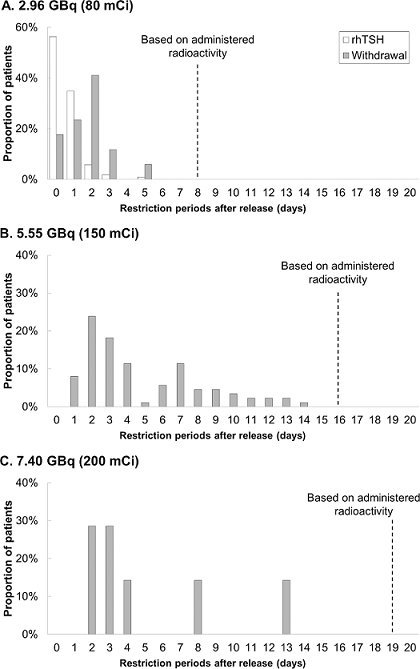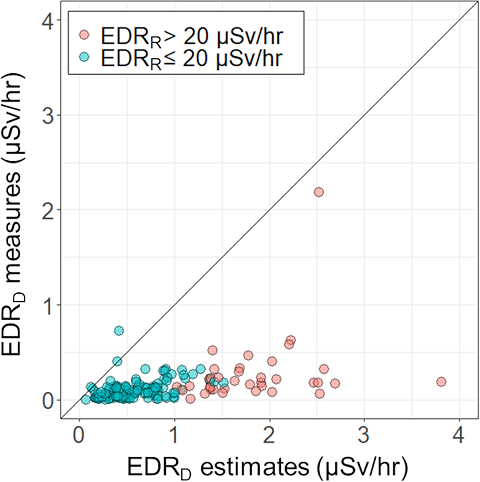글로벌 연구동향
핵의학
- 2021년 07월호
[PLoS One.] A practical individualized radiation precaution based on the dose rate at release time after inpatient 131I ablation therapy울산의대 / 한상원, 진소영, 류진숙*
- 출처
- PLoS One.
- 등재일
- 2021 May 21
- 저널이슈번호
- 16(5):e0251627. doi: 10.1371/journal.pone.0251627. eCollection 2021.
- 내용
Abstract
Introduction: Retained radioactivity of 131I after ablation therapy largely differs in each patient according to factors including the amount of remnant thyroid tissue, renal function, and use of recombinant human thyroid-stimulating hormone. To reduce unnecessary restriction of patient's daily life after inpatient 131I ablation therapy, we propose a practical individualized method for radiation precaution based on dose rate at release time.Methods: We evaluated 215 patients with differentiated thyroid cancer who underwent inpatient 131I ablation therapy following total thyroidectomy. Effective dose equivalent rates at 1-m distance were measured upon release (EDRR) on day 2 and during delayed whole-body scan (EDRD) visits on day 6‒8 after 131I administration. The biexponential model was designed to estimate total effective dose equivalent to others. To assess conservativeness of our model, EDRD estimated by our model was compared with measured EDRD. EDRR-based periods of precaution not to receiving 1 mSv of radiation exposure were estimated and compared with those based on administered radioactivities on American Thyroid Association (ATA) recommendations.
Results: The EDRR ranged from 1.0-48.9 μSv/hr. The measured EDRD were equal to or lower than estimated EDRD in all patients, except for one, indicating that our model is sufficiently conservative. According to our model, no subjects needed additional daytime restriction after release. The maximum permissible times for public transportation use were longer in all patients compared with those based on administered radioactivities. Nighttime restriction periods were significantly shorter than those based on administered radioactivity; median periods requiring sleeping apart were 0 (range, 0‒5), 4 (range, 1‒14), and 3 (range, 2‒13) days after release in patients treated with radioactivity doses of 2.96, 5.50, and 7.40 GBq, respectively, needing 8, 16, and 19 additional days, respectively, based on administered radioactivity.
Conclusions: Radiation safety instructions using proposed method based on EDRR of individual patient could safely reduce the burden of radiation precaution.

그림1. 퇴원선량 기반 (본 연구) 모델과 치료용량 기반 모델의 격리기간 비교.

그림2. 퇴원선량 기반 (본 연구) 모델로 예측선량과 실제 측정선량의 비교. 본 연구 모델이 충분히 보수적이고 안전함을 시사함.
Affiliations
Sangwon Han 1 , Soyoung Jin 2 , Seon Hee Yoo 1 , Hyo Sang Lee 3 , Suk Hyun Lee 4 , Min Ji Jeon 5 , Jin-Sook Ryu 1
1 Department of Nuclear Medicine, Asan Medical Center, University of Ulsan College of Medicine, Seoul, Korea.
2 Department of Nuclear Medicine, Nowon Eulji Medical Center, Eulji University School of Medicine, Seoul, Korea.
3 Department of Nuclear Medicine, Gangneung Asan Hospital, University of Ulsan College of Medicine, Gangneung, Korea.
4 Division of Nuclear Medicine, Department of Radiology, Kangnam Sacred Heart Hospital, Hallym University College of Medicine, Seoul, Korea.
5 Department of Endocrinology, Asan Medical Center, University of Ulsan College of Medicine, Seoul, Korea.
- 연구소개
- 방사성요오드 입원치료 환자는 잔류방사능량을 반영하는 외부 방사선량률을 측정하여 기준을 만족해야 법적으로 퇴원이 가능합니다. 환자는 퇴원 후에도 일정기간 동안 주변사람의 방사선 노출을 줄이기 위해 주의 지침이 필요합니다. 현재 진료현장에서는 치료 용량에 따라 주의 기간이 제시되고 있으나, 실제 필요한 주의 기간을 결정하는 체내 잔류방사능량은 퇴원 시 측정된 방사선량률로 보면 환자 별로 큰 차이가 있습니다. 이 연구에서는 방사성요오드 치료를 시행한 갑상선암 환자들에게 퇴원 후 방사선안전 지침의 주의 기간을 개인별 맞춤으로 제시할 수 있도록, 각 환자의 퇴원 시 측정한 방사선량률에 근거하여 계산하는 모델을 만들고 검증하였습니다. 그 결과 이 모델을 적용하면 치료용량에 기반한 지침에 비하여 안전하면서도 훨씬 짧은 기간의 주의만 필요함을 확인하였고, 이를 적용하면 과도하고 불필요한 격리로 인한 불편함을 감소시킬 수 있을 것으로 기대됩니다. 개별 환자의 측정 선량률을 입력하면 본 모델로 산출한 주의 기간이 자동 계산되는 스프레드시트 엑셀파일이 Open access 논문에 첨부되어 있으므로, 여러 치료 기관들에서 간단하고 편리하게 실용적으로 활용될 수 있기를 희망합니다.
- 덧글달기








편집위원
방사성요오드 치료 후 체내 방사능량을 개인의 특성에 따라 평가하여퇴원 시기를 결정할 수 있음을 보여주 흥미로운 연구임. 환자에 따른 필요한 격리기간 개별화할 수 있어, 방사성요오드 치료를 시행하는 임상가에게 관심을 끌 연구로 생각됨.
덧글달기닫기2021-06-30 16:09:49
등록